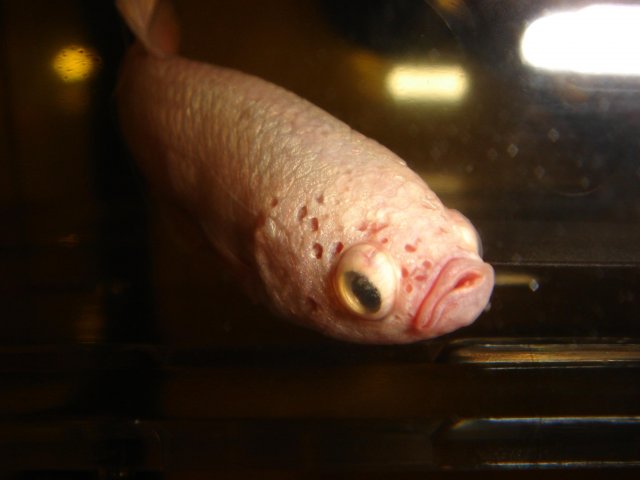Betta Hole In Head: Causes, Treatment, Prevention
If you’ve noticed small holes or pits on your betta fish’s head, don’t panic. While alarming, hole-in-the-head (HITH) disease is a common ailment that can be successfully treated and even prevented with the proper knowledge and care. This guide will walk you through everything you need about HITH, from its causes and symptoms to treatment and prevention strategies.
What is Hole in the Head Disease?
HITH is not just a cosmetic issue; it’s a sign of an underlying health problem. The disease manifests as small holes or lesions, usually on the head but sometimes along the body. These holes can deepen and become infected if left untreated. It’s important to distinguish HITH from the natural sensory pits that some betta fish have along their lateral line. These pits are typical and not a cause for concern.

credit aquariumcoop.com
Causes of Hole in the Head Disease
Click here if you want to learn how to heal ‘hole in head’ phenomenon
HITH has several potential causes, often acting in combination:
- Poor Water Quality is the most common culprit. High levels of ammonia, nitrite, and nitrate, along with improper pH and temperature, stress the fish and weaken their immune systems.
- Parasites and Bacteria: Hexamita, Spironucleus, and other microorganisms can thrive in poor water conditions and infect the fish, leading to HITH.
- Nutritional Deficiencies: A lack of vitamins (especially vitamin C) and minerals can compromise the fish’s immune response, making them more susceptible to disease.
- Environmental Stress: Factors like overcrowding, aggressive tank mates, or inadequate hiding places can stress the fish, leading to health problems.
- Genetics: Some bettas may have a genetic predisposition to HITH.
Symptoms to Watch For
Early detection is crucial for successful treatment. Watch for these signs:
- Small holes or pits: Initially, they may look like tiny indentations on the head.
- Discoloration: The area around the holes may lose color or appear red and inflamed.
- Mucus or slime: Excess mucus production around the head.
- Behavioral changes: Loss of appetite, lethargy, hiding, or rubbing against objects in the tank.

credit: Aquariacentral.com
Treating Hole in the Head Disease
If you suspect HITH, act quickly. The earlier you intervene, the better the chances of recovery. Treatment usually involves:
- Improving Water Quality: Perform frequent water changes, test water parameters regularly, and ensure the tank is adequately filtered and maintained.
- Medications: Anti-parasitic and antibacterial medications may be necessary. Consult a betta fish care guidebook for diagnosis and treatment recommendations.
- Dietary Adjustments: To boost the fish’s immune system, offer a high-quality diet rich in vitamins and minerals. Consider adding vitamin C supplements.
- Stress Reduction: Optimize the tank environment by providing adequate hiding places, removing aggressive tank mates, and avoiding overcrowding.
Preventing Hole in the Head Disease
Prevention is always better than cure. Here’s a comprehensive plan to keep your betta fish healthy and thriving:
- Maintain Pristine Water Quality: This is the cornerstone of betta health. Perform weekly partial water changes of 25-50%, depending on your tank size and bioload. Use a reliable water testing kit to monitor ammonia, nitrite, and nitrate levels and keep them within safe ranges for bettas (ammonia and nitrite at zero, nitrate below 20 ppm). Invest in a good-quality filter appropriate for your tank size and ensure it’s properly maintained.
- Provide a Nutritious Diet: Betta fish are carnivores and require a protein-rich diet. Choose high-quality betta pellets as the staple food, and supplement with frozen or live bloodworms, brine shrimp, or daphnia a few times a week. Avoid overfeeding, as this can contribute to water quality problems.
- Create a Stress-Free Environment: Stress is a significant weakening factor for fish. Provide your betta with an appropriately sized tank for its needs (at least 5 gallons for a single betta). Decorate the tank with live or silk plants to offer hiding spots and enrich the environment. Avoid tank mates that could nip at the betta’s fins or bully it. If you must have tank mates, choose peaceful community fish like celestial pearl danios or neon tetras.
- Quarantine New Fish: New arrivals can introduce diseases to your existing fish. Set up a quarantine tank and house new fish there for several weeks before introducing them to the main tank. This allows you to monitor them for any signs of illness and prevents potential outbreaks in your main display.